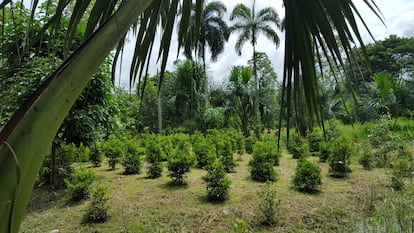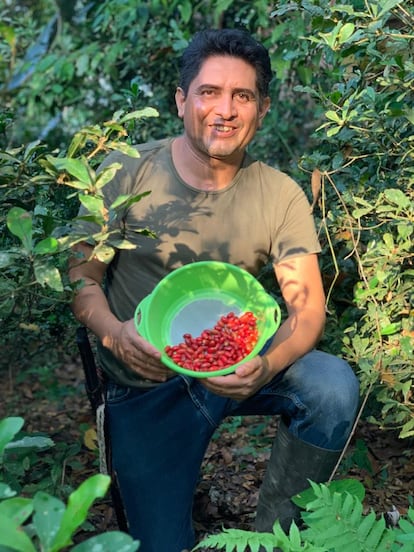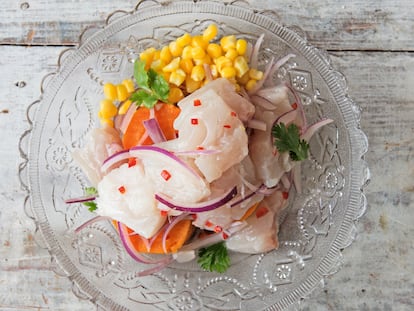Zafru, the ‘miracle fruit’ that turns sour into sweet
European colonizers came across the West African berry in the 17th century. Now, it is experiencing a revival in kitchens around the world
During the 17th and 18th centuries, European sea routes to the West Indies and the Americas made strategic stops along the West African coast. Travel diaries documented these journeys, capturing the news and impressions of each new stop along the way. In 1724, French captain Chevalier de Marchais came across a unique eating habit among African tribes in Ouidah, a city in southern Benin. Before eating, the people would collect small red berries from a bush, chew them briefly and then spit out the seeds. This ritual (previously described by a Danish missionary named Müller in 1664 during a visit to Ghana’s Fetu region) enhanced the taste of their food and added a sweet touch to the otherwise acidic and sour flavors. Knowledge of that ritual led to global experimentation and research ever since.
The synsepalum dulcificum is a tropical shrub from the west coast of Africa, specifically the Ivory Coast, Benin, Nigeria, Cameroon, Togo, Gabon, and Congo, as well as inland areas of the Central African Republic and the Democratic Republic of the Congo. The shrub plays a significant role in traditional African medicine, with its roots, berries and seeds being used by locals during consumption of acidulated cornbread, unripe fruits, palm wine and beer. The berry is especially useful for water that isn’t otherwise drinkable. The unique property of this “miracle berry” is its ability to transform sour flavors into sweetness. Biotechnologist Adrián Menéndez Rey says this is due to a protein in its pulp called miraculin, which stimulates the taste of sweetness without impacting the glycemic index. Menéndez has conducted research on people with taste disorders, focusing on the immunogenic, biological activity of Synsepalum dulcificum in food.

Around 65 years ago, Zafru was brought to Ecuador by an American named Donald Brainar. In 1991, Valerio Tapia, an exotic plant enthusiast, purchased a Synsepalum dulcificum bush from Brainar. Tapia saw the potential of the fruit and began propagating and cultivating the shrub. Raquel Salazar, the co-CEO of Zafru Fruta Milagrosa, the main producer in Ecuador, says other companies around the world like MBerry in Taiwan and Baïa Food in Spain source the fruit from Ghana to make Zafru products. “When the protein in the pulp touches the taste buds, it changes them for 30 minutes, making acidic flavors taste sweet,” said Salazar, advising people to chew Zafru before consuming bitter foods and not to use it as an ingredient. Whenever Salazar introduces someone to Zafru, she first plays a little game. She offers people some lime wedges and tells them to take a bite. The sour taste invariably makes faces wince and mouths pucker. Then she gives them Zafru berries to chew. After that, Salazar tells them to try the lime again and watches their amazement when the sour has turned into sweet, enabling them to eat the entire lime with relish.
Pastry chef Joaquín Araque of Tributo restaurant in Quito uses Zafru extensively in his delicacies. “We specialize in making pastries for folks who can’t have sugar, as well as those who follow gluten- and dairy-free diets. That’s why customers with specific dietary restrictions come to us. Instead of using the fruit as an ingredient, we use it to create delightful experiences. Just before serving a dessert, we explain what Zafru is and even give them a little taste of a tangy lemon to see their reactions before and after. Then, they can savor our sugar-free desserts, knowing that the berries will add a touch of sweetness to every bite.”

At AYAWASKHA Gastro, an Ecuadorian restaurant in Madrid, chef-owner Miguel Ángel Méndez has introduced an initiative called the AYAWASKHA Connection Experience, which aims to bring Ecuadorian cuisine closer to both the European public and to Ecuadorians themselves. “We’re really focused on building a unique gastronomic identity,” Méndez explains. “We’ve been using this fruit to create some amazing sensory experiences, like Jipijapa ceviche. We’ve also tried it in tartares and even in desserts that have a tangy kick. It’s definitely an experimental ingredient, so not everyone is ready to try it at a restaurant. But those who are open to new culinary adventures are in for a treat.”
Homaro Cantu, who was one of the Chicago’s most promising young chefs, showcased the full Zafru experience at his restaurant, Moto. Cantu encouraged diners to explore the fruit and discover a variety of sugar-free recipes featured in The Miracle Berry Diet Cookbook. This cookbook includes over 150 simple recipes that enable you to reduce calories without compromising on flavor. It also provides answers to common questions about the fruit, such as how it works, where to find it, and even how to grow it. “It’s got huge potential in the kitchen, and you can whip up all sorts of recipes — both savory and sweet — to enjoy it,” said Juan Pablo Holguín, a cooking teacher at the Regional Autonomous University of the Andes in Quito. “I wouldn’t suggest adding it to recipes as you won’t experience that amazing flavor transformation. The ideal way to consume it is beforehand, especially when indulging in sugar-free desserts or dishes with a good amount of acidity, like ceviche.”
This berry is perfect for preparing various dishes at home that include acidic ingredients, like fruit salads, cakes, juices and smoothies. You can also use it in ceviche, spicy sashimi tiraditos, sauces, salads and juices. Simply use a base of acidic citrus fruits such as limes, lemons, grapefruits and tangerines, or semi-acidic fruits such as pineapples, tamarinds, plums, blackberries and currants. No need to add sugar! After preparing your food, make sure to thoroughly chew the miracle fruit for at least 20 seconds, allowing it to coat your taste buds and turn all those acidic flavors into delicious sweetness.
Sign up for our weekly newsletter to get more English-language news coverage from EL PAÍS USA Edition
Tu suscripción se está usando en otro dispositivo
¿Quieres añadir otro usuario a tu suscripción?
Si continúas leyendo en este dispositivo, no se podrá leer en el otro.
FlechaTu suscripción se está usando en otro dispositivo y solo puedes acceder a EL PAÍS desde un dispositivo a la vez.
Si quieres compartir tu cuenta, cambia tu suscripción a la modalidad Premium, así podrás añadir otro usuario. Cada uno accederá con su propia cuenta de email, lo que os permitirá personalizar vuestra experiencia en EL PAÍS.
¿Tienes una suscripción de empresa? Accede aquí para contratar más cuentas.
En el caso de no saber quién está usando tu cuenta, te recomendamos cambiar tu contraseña aquí.
Si decides continuar compartiendo tu cuenta, este mensaje se mostrará en tu dispositivo y en el de la otra persona que está usando tu cuenta de forma indefinida, afectando a tu experiencia de lectura. Puedes consultar aquí los términos y condiciones de la suscripción digital.
More information
Archived In
Últimas noticias
David Bowie, the galactic thinker who encouraged us to break new ground
John Berger and the loss of rural culture
From police officer to bloodthirsty kidnapper: Terror in Mexico during the years of ‘The Ear Chopper’
Alain Aspect, Nobel laureate in physics: ‘Einstein was so smart that he would have had to recognize quantum entanglement’
Most viewed
- David King, chemist: ‘There are scientists studying how to cool the planet; nobody should stop these experiments from happening’
- Reinhard Genzel, Nobel laureate in physics: ‘One-minute videos will never give you the truth’
- Oona Chaplin: ‘I told James Cameron that I was living in a treehouse and starting a permaculture project with a friend’
- Mexico completes its trade shift with the entry into force of tariffs on China and countries without trade agreements
- Sinaloa Cartel war is taking its toll on Los Chapitos










































